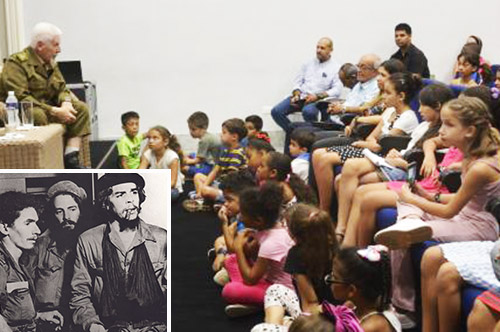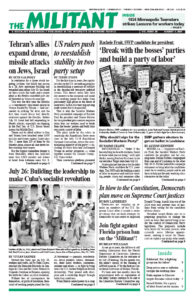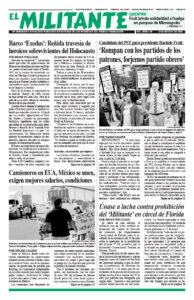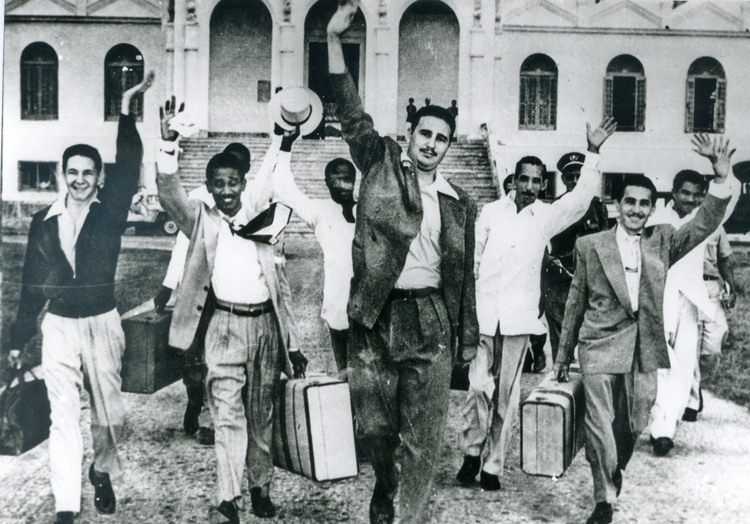Seventy-one years ago on July 26, workers and youth, led by Fidel Castro, attacked the Moncada Barracks in Santiago de Cuba and the Carlos Manuel de Céspedes Garrison in Bayamo, opening the battle for Cuba’s socialist revolution.
Without fear of consequences for themselves, or political hesitation, thousands of working people joined the July 26 Movement — peasants, woodworkers, house painters, bakers, shoemakers, sheet metal workers, carpenters, students and others — to fight to bring down the U.S.-backed Fulgencio Batista dictatorship. They proved with discipline and a leadership forged through battle they could win.
When Batista seized power in a coup on March 10, 1952, hundreds of thousands of working people in Cuba were unemployed. Some 3 million, half of the island’s population, had no electricity. More than half lived in huts, in slums, without the most minimal sanitary facilities. In the cities, rents took almost one-third of family income. Peasants could only work in the growing season, or during the short sugar harvest. There were no teachers for 70% of rural children. Many became convinced that the only road forward was to fight.

Ramiro Valdés, a vice president of Cuba and Commander of the Revolution — a title earned by top leaders of the rebel troops under Fidel Castro’s command in the 1950s — spoke with a group of children at the Fidel Castro Ruz Center in Havana July 10 about the conditions that led him and those of his generation to join the fight to end the dictatorship and the misery and indignity produced by capitalist exploitation.
Becoming a revolutionary “is not a career that you study for,” Valdés explained on many occasions. “You become a revolutionary because you rebel, you refuse to accept the conditions of life that you face” and draw inspiration from history and those who came before us.
The then 21-year-old trucking assistant, who hauled sugar cane for the Pilar and San Cristóbal mills, set out to find others like himself looking to fight. After hearing young lawyer Fidel Castro denounce Batista on the radio, he went to meet him.
He and his friends from the impoverished La Matilde neighborhood of Artemisa put themselves at Castro’s disposal. Under his leadership they learned to act in a disciplined and politically effective way. Many of these militants, including Valdés, were selected by Castro to participate in the attack on Moncada.
A revolution reignited
Imprisoned until 1955 and then exiled from Cuba, Valdés joined Castro in Mexico and returned to Cuba on the Granma with him, looking to take on its dictatorship. Fidel, he told the children in Havana, held out to the crew the key to victory — resist, resist, resist — and confidence the people would support and join in a war that they would consider just.
Valdés fought as second in command in Che Guevara’s Rebel Army Column 4 and later as commander of Column 8 in Las Villas.
Many other lifelong leaders of the Cuban Revolution had similar origins. Juan Almeida Bosque, a black Cuban who worked as a bricklayer from the age of 11, also decided after the coup it was time to act. He went to the University of Havana campus to protest, joining an action organized by Castro. He joined the Moncada attack, the guerilla struggle against Batista and went on to become a central leader of the Cuban Revolution.
Haydée Santamaría participated in the attack on Moncada and was imprisoned afterward for seven months. She became a founding member of the July 26 Movement in 1955, fought in the revolutionary war and played leading roles over the decades.
They, and others like them, joined Castro in providing leadership for the Cuban Revolution.
U.S. imperialism has never forgiven the revolution for carrying through on its program. This includes the Agrarian Reform Law, which put land into the hands of hundreds of thousands of landless peasants, and mobilizing workers to carry through nationalization of U.S.-owned banks and businesses, as well as those of Cuba’s capitalist class.
Cuba’s socialist revolution — and what it showed about the capacities of working people — stands as a powerful example for us today.
Washington says the Cuban Revolution must disappear, Valdés said in a Cuban television interview. “We have to be conscious of that, because we are, and will continue to be a hard nut to crack. We are a bone stuck in their throat they can’t swallow.”
Now 92 years old, Valdés urged the youth in Havana to study the Cuban Revolution — and Fidel Castro — in order to continue to defend it. “You have to know Fidel more and more,” he said.


